Amazake: Discover the Delicate Charm of Japanese Sweet Sake
Feb 28,2013
Amazake: Discover the Delicate Charm of Japanese Sweet Sake
Feb 28,2013
Regular Japanese meals have long been enriched by many fermented foods including miso, soy sauce, vinegar, mirin rice wine, and fermented natto soybeans.
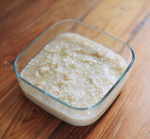
Fermented foods and their umami flavorings are produced by the actions of endemic microorganisms and offer a host of benefits to the human body. Fermented foods, moreover, contain the hard-earned wisdom of our ancestors and are deserving to be passed on to future generations. In this series, we will present recipes that are easy to incorporate into today’s lifestyles while getting at the essence of fermented foods.
In Part 1, we will look at amazake, a sweet drink made from fermented rice malt that is in the spotlight for its health and beauty benefits.
▶Shio Koji, Salted Koji & Japanese Food with a Koji-ya
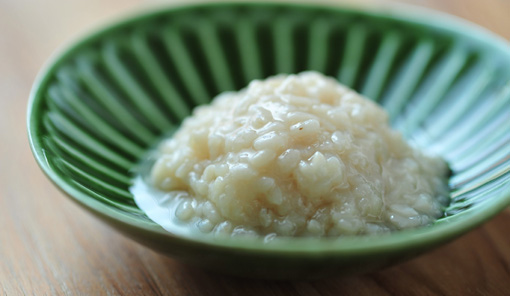
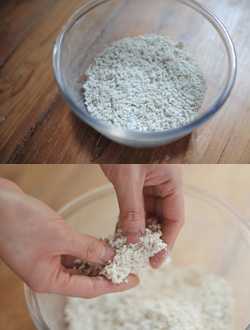
Amazake is often regarded as a sweet alcoholic drink for the cold winter months, as it is served during the traditional first shrine or temple visits of the New Year. But, in fact, it has been a common summer drink since the Edo period (1603 to 1868). Even now, amazake is used figuratively to represent summer in the world of haiku poetry. To learn more about the origins of amazake, we spoke with cooking expert Yugi Satomi.
“The major modern amazake brands contain some alcohol because the amazake is made by mixing sugar with saké lees and then diluting it with hot water. The amazake of old Japan, however, involved sprinkling rice koji malt on rice and letting it ferment. Because this form of amazake contains no alcohol, it is also called amakoji or koji amazake. Amazake made with rice koji was consumed in the Edo period to ward off summer fatigue, and scholars say that it was a custom among samurai to start with amazake before drinking alcohol to prevent them from getting sick from overindulging.”
Amazake was drunk in the summer when the body is more easily tired because it contains plenty of nutrients such as B vitamins, glucose, and amino acids. It is also special because it contains all nine essential amino acids that the body cannot produce on its own. Furthermore, the carbohydrates amazake contains are quickly used up as energy, meaning that you are not likely to gain weight from drinking amazake.
Yugi has incorporated this wonder drink into her daily life. “I started drinking amazake regularly about two years ago, and I’ve noticed that I don’t get tired as easily and my skin condition is better. Since it contains ingredients that are beneficial for your skin and hair, it’s like a beauty serum you can drink.” This so-called natural supplement is sold in stores, but you can make it at home too.
“Commercially produced amazake is pasteurized to stop the fermentation process, whereas in raw homemade amazake, the nutrients continue to live. And more than anything, it’s simply delicious. I recommend drinking it straight if you wish to enjoy it without any fuss. For me, I always have it as a homemade drink, made by blending fruit, soy milk, and amazake in a blender. You can enjoy lots of flavor variations by adding your favorite fruits.”
Amazake is also useful as a seasoning and can be used in place of sugar or mirin. Marinating meat or fish in amazake has the effect of multiplying the umami.
“If you use amazake instead of yeast in pizza dough, it will turn out with a springy texture. Plus, amazake does not have a heavy sweetness, so it’s delicious even when used in sukiyaki hot pots or simmered fish dishes. And I make French toast with eggs and amazake, instead of milk and sugar.”
Amazake is very versatile and provides endless cooking variations. Although it is a traditional Japanese fermented food, there is no need to limit it to Japanese cuisine. The ease with which you can add amazake to modern lifestyles is one of its most compelling points.
“There’s no reason to overthink it. Rather than starting something brand new, find something familiar and try adding amazake to your regular dishes. You can make amazake in an evening, and I find enjoying the fermentation process fun as well.”
Amazake is a fermented food backed by the power of koji and the wisdom of our ancestors. Have it straight or add it to your cooking. Either way, try giving amazake a go in your regular cooking routine.
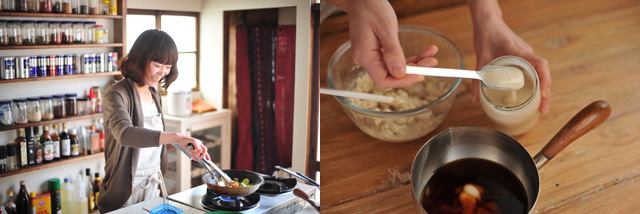
Recipe for homemade amazake
Ingredients (easy-to-prepare quantity)
Rice…1 cup
Koji…200grams
Water…750mL
Directions

1.Wash the rice well and let it soak for at least 30 minutes. Add the water and rice to a pot and make it into rice porridge.
↓
2.Thoroughly break up the koji with your hands, add it to the somewhat cooled rice porridge, and mix everything well.
↓
3.Transfer the mixture to a rice cooker, place a weight on the lid, and leave to ferment for around eight hours while keeping it warm, making sure to leave a gap between the cooker and the lid with a chopstick or something similar.
↓
4.The amazake is now complete. Yugi recommends mixing it with a mixer or blender and using it as a paste.
【POINT】
■Adjust the amount of water to your liking. If you prefer a thinner consistency, make the rice porridge with a bit more water.
■Use the rice cooker with the keep warm function on. Do not use the cook function. If the temperatures get too high, they will kill off the koji bacteria. This is why you should leave a gap while letting it ferment.
■Ideally, you want the mixture to ferment at around 60°C. Some rice cookers, however, will run hotter even if a gap is left, which may shorten the fermentation time. Check the taste at around the six-hour mark. If it has a faint koji smell and tastes sweet, it is done.
■You can store amazake in the refrigerator for around one week to 10 days. The fermentation will continue to progress bit by bit and the flavor will change.
■You can also make it in a yogurt maker.
Recipe for canola flower salad dressed with tofu, sesame, white miso, and amazake

Ingredients (two-person serving)
Canola flowers…Half a bunch
[A]
Momen (firm) tofu…Quarter of a block
Ground sesame seeds…One tablespoon
Amazake…Two tablespoons
White miso…One tablespoon
Light soy sauce…1/2 teaspoon
Directions
1.Boil the canola flowers in salted boiling water. Once boiled, drain and cool them quickly by fanning them, and cut into bite-sized lengths.
2. Wrap the tofu in paper towels and weigh them down to press out the moisture. Once drained, place the tofu in a bowl, mash it with a spatula, and finally use a whisk to smooth it to the desired consistency.
3. Take all the ingredients from list [A] and place them in the bowl from Step 2 and mix well. Once mixed, pour the dressing over the canola flowers and toss everything together.
Recipe for a grilled vegetable and bacon salad with an amazake sauce dressing

Ingredients (two-person serving)
Asparagus…Two stalks
Red and yellow bell peppers…1/8 of each
Zucchini…1/3
Radish…Two
Chicory and watercress…To taste
Bacon…Two slices
Olive oil and black pepper…A little of each as needed
[Amazake sauce]
Amazake paste…Two tablespoons
Extra virgin olive oil…Two tablespoons
Lemon juice…One tablespoon
Salt…1/2 teaspoon
Directions
1. For the asparagus, remove the tough skin at the base with a peeler, cut in half, and then cut in half lengthwise. Cut the bell peppers into long, easy-to-eat strips, and slice the zucchini into round pieces. Cut the radishes and their leaves in half lengthwise. Cut the bacon into pieces two to three centimeters wide.
2. Heat the olive oil in a frypan and grill the vegetables and bacon until they are nicely browned.
3. Arrange the vegetables from Step 2 on a plate with the chicory and watercress and grind some black pepper on top. Dress with the amazake sauce and serve.
[Amazake sauce]
Place all the sauce ingredients in a bowl and mix thoroughly.
Recipe for yellowtail simmered in soy sauce
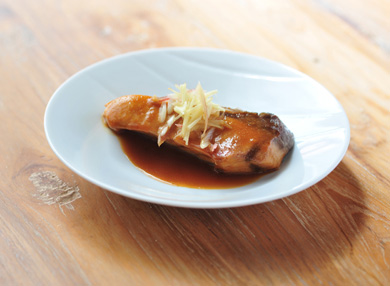
Ingredients (two-person serving)
Yellowtail (fillets)…Two fillets
Ginger…One slice
Myoga ginger…One bud
[A]
Amazake paste…Three tablespoons
Soy sauce…Three tablespoons
Saké…Six tablespoons (90 mL)
Ginger…One slice
Directions
1. Wipe the yellowtail well to remove any moisture. Peel the ginger and cut into thin pieces. Cut the myoga ginger in half lengthwise and then cut it diagonally into thin pieces. For the ginger in list [A], cut into thin pieces with the skin on.
2. Add all the ingredients from list [A] to a pot, bring to a boil, and then add the yellowtail. Once it boils again, turn the heat to low and simmer for about eight minutes while basting the fish with a spoon.
3. Arrange the fish on a plate and pour a little of the cooking broth on top. Garnish with the ginger and myoga ginger strips.
Recipe for amazake French toast
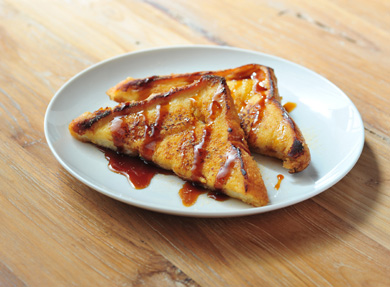
Ingredients (two-person serving)
Four-slice loaf of soft white bread…Two slices
Butter…Soybean fl10 grams
Soybean flour and brown sugar syrup…To taste
[A]
Amazake paste…100 mL
Medium-sized egg…One
Directions
1. Put the ingredients from list [A] in a mixing bowl and mix well. Add the bread and coat with the mixture, using a spatula to spread the coating evenly. Cover with plastic wrap and leave overnight.
2. Melt the butter in a frypan and cook the bread from Step 1 over a low to medium heat, browning both sides.
3. Serve on a plate, sprinkle with soybean flour and pour brown sugar syrup on top.

After managing cafés in Kichijoji, Tokyo, Yugi became a certified café planner and food coordinator. She served as an instructor at a leading culinary school as well as engaged in food and food-space work, including café planning and production and menu development. She is currently a cooking expert and café planner. She opened Studio Sato Kitchen, a kitchen studio where she runs the Sato Kitchen Cooking School. Yugi has written a number of books including Fermented Food Recipes for Beauty: Salted Koji, Amazake, Yogurt, and Natto (Jakometei Publishing).